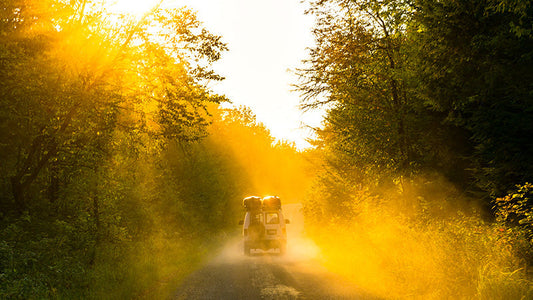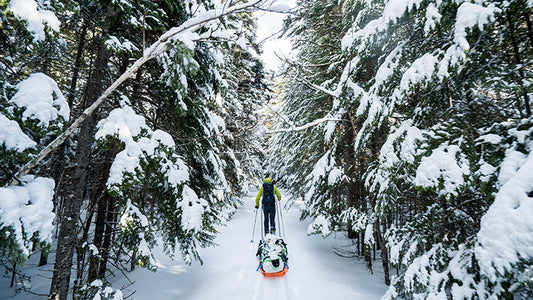We were standing near the summit of Mt. Katahdin, looking out at where the infamous Knife’s Edge ridgeline traverse was supposed to be. The weather that morning had called for clearing skies, but here we stood, not being able to see more than 20 feet in front of us. It was out there somewhere, but we had no idea where. As the wind whipped past us and threatened to push us off the ridge, we made the decision: even though we were so close to the summit, it was time to descend.
 Mt. Katahdin is a fickle beast. Touted as an alpinist’s playground, the glacial cirque in Baxter State Park is composed of a collection of sharp mountain ridges surrounding Chimney Pond. In the winter, waterfalls and seeping water freeze up and turn Katahdin’s gullies and rock faces into spectacular multi-pitch alpine climbs.
Mt. Katahdin is a fickle beast. Touted as an alpinist’s playground, the glacial cirque in Baxter State Park is composed of a collection of sharp mountain ridges surrounding Chimney Pond. In the winter, waterfalls and seeping water freeze up and turn Katahdin’s gullies and rock faces into spectacular multi-pitch alpine climbs.
However, as anyone who has ventured into Baxter in the winter can tell you, the weather is always a wildcard. I’ve had many friends who have spent an entire week fogged in at the Chimney Pond bunkhouse located at the base of the climbs. Others have made the trek to Katahdin every year for six years and have never climbed a thing.
The unpredictability of the weather is confounded by the advanced logistics surrounding any trip to Katahdin. With any other climbing location in the Northeast, climbers scour the weather reports for days ahead of time, and if the forecast calls for poor conditions they stay home, do laundry, and reply to e-mails instead.
This luxury doesn’t exist for Mt. Katahdin expeditions; bunkhouse reservations must be made months ahead of time, far further than any optimistic weather reporter can predict. If your scheduled reservation arrives and the weather report looks iffy, you cross your fingers and gear up anyways, hoping that in the day it takes you to travel the 15 miles from the parking lot to basecamp at Chimney Pond, the forecast may change.
Now, if this sounds like absolute insanity to you, you aren’t alone. Hell, a majority of ice climbers, a group that most consider to be insane by definition, never venture into the Katahdin alpine playground. It’s a right that’s reserved only for those with a particular affinity for suffering.
Our group of four was scheduled to join those ranks. After more than a month of planning itineraries, coordinating schedules, and preparing gear, we found ourselves on the eve of our trip, anxiously running over our equipment checklists to ensure we didn’t miss any small detail. After enough stressing we finally set our alarms for 3AM and prepared for bed, ready to get an early start for the long drive from New Hampshire to Millinocket, Maine.
DAY 1: We pulled up to the trailhead mid-morning and were welcomed by a gust of frigid air as we stepped out of our cars. After the final preparations were made and our gear was packed tightly away, we stepped into our skis and started off. It wasn’t more than a minute after leaving the cars when we encountered the first hiccup in our trip: some of our our pulk sleds were misbehaving. A pulk sled is an integral part of any trip to Katahdin, and the ability to move the weight of your pack off your shoulders and onto a sled you are pulling behind you is key. Unfortunately, a couple of us had put our trust in the YouTube experts when measuring and building our sleds, and every backstep caused the front of our sled to run over the rear of our skis. Frustration quickly ensued. It wasn’t long before we stopped and made adjustments, a pattern that would continue many times through the length of the trip.

Push, glide. Push, glide. As we skied mile after mile of the approach, the familiar sounds of skins zipping across stiff snow soon became a monotonous tone. Shadows shifted as the day progressed, conversations dwindled, and swears were exclaimed over sled designs as the sun dropped below Katahdin’s enormous form and we finally pulled up in front of the Roaring Brook Bunkhouse.
The original plan had been to ski the entire 16 miles to the Chimney Pond Bunkhouse on day one, but our late start prompted us to instead spend the night at Roaring Brook. We made a fire in the woodstove and enjoyed our Good To-Go meals as the bunkhouse warmed into our cozy sleeping quarters for the evening ahead.

DAY 2: The trail was illuminated only by headlamps early the next morning as we stepped out of the cabin to a cloudy and dark sky. Sleds packed, backpacks shouldered, and skis attached, we headed out on tired legs. The remaining steep 3.3 miles to Chimney Pond dropped away slowly, but eventually we were standing at the South Basin, looking up at Katahdin’s enormous ridgeline, a sight that seemed to belong more in the Canadian Rockies than New England.
We dropped our gear at the Bunkhouse and headed out to explore the climbs. A ranger had warned us that many of the classic alpine routes had been dramatically affected by rain the week before, and his observations were soon confirmed by our team as we wandered around Katahdin’s base. Thin ice, avalanche debris, and bare rock was everywhere we looked. Disappointed, we made our way back into the bunkhouse to enjoy dinner and plan for the next day as dusk approached.
DAY 3: “Today’s the day,” I thought as my eyes popped open in my bunk. The previous night we had decided to take on a smaller objective after accounting for the bony conditions existing all over the South Basin. The plan was now to climb The Chimney, a moderate snow/ice climb rated at WI2. The guidebook lists it as an easy undertaking, so our team had opted to sleep in and hope the weather cleared later in the day as predicted.
The skies were cloudy and the winds howled as we made our way across Chimney Pond, headed back up the path we had forged the day before. An hour after leaving the warmth of the bunkhouse, we found ourselves at the base of The Chimney and started racking up with crampons, ice tools, and the rest of our climbing gear.

Up into the clouds we climbed. The higher we climbed, the foggier it became. The temperature hovered around 30 degrees, and frost began to build up on every piece of exposed gear. Winds ripped up The Chimney, then moments later would chance direction and head straight down, threatening to push us off our stances. We reached a chockstone blocking the path, roped up, and fired off a short section of mixed climbing, utilizing small pockets of ice and snow as well as cracks in the rock for hand and foot holds.
Once back on snow, we continued ascending until we reached a cave where we enjoyed a quick snack and a respite from the roaring winds. Repeating the pattern, we roped up again and made our way up and around this second chockstone.

On a good snow year one can climb the entire Chimney in the snow, then slide back down or even ski the descent. This was not a good snow year. Above the second chockstone we encountered more bony conditions as we continued up through giant stone arches and rock scrambles, aided through the challenging sections by our ice tools and crampons. We stepped onto the summit of Chimney Peak and looked out at where the Knife Edge was supposed to be, connecting us to Baxter Peak. Nothing but white fog surrounded us.
Here we stood, like many had stood before us, at the mercy of Katahdin’s weather. The forecasts had been wrong. They had called for clearing skies and moderate windspeeds, and as we braced ourselves against the intensifying gusts we cursed under our breath. In the native Penobscot language, Katahdin means “The Greatest Mountain,” and it was loudly reminding us of its namesake. Retreat was imminent.
Down we climbed, struggling over bare boulders and trying to fight back against Katahin’s dwindling patience as the gusts kicked up. The wind roared, and small pieces of windblown ice and snow smashed into our bare faces at 80mph. Tucking behind the only large boulder we could find, we adorned goggles and pulled our neck gaiters higher. Inches from each others’ faces, we yelled commands at the top of our lungs then continued the descent.
We braced ourselves with every foot placement. If we left ourselves unbalanced, the mountain would capitalize with a tremendous blast of icy air to send us stumbling fifteen feet sideways. Katahdin had lost its patience with our crew. It now seemed to be trying to kill us.
We finally descended out of fog and watched in awe as clouds ripped over the ridge we were standing on. Glancing to the west, we saw the glow of the setting sun and knew we had very little time left until we were battling the wind in the dark.

Wind, snow, ice, and rock continued, but as the last light disappeared from the sky we exhaustedly ambled into the protection of the forest at the edge of Chimney Pond. We walked in silence back to the bunkhouse, mentally and physically drained past the point of talking. No one spoke a word as we silently threw our gear into the corner of the bunkhouse and fired up our stoves to make dinner. Only once we started eating did the conversation begin again.
DAY 4: The rays of sun beamed on Katahdin’s ridge, surrounded by clear skies and a couple wispy clouds. We stood at the base of Chimney Pond, looking up at the mountain that had battled us so fervently only 12 hours ago. It seemed to know that we had no option of climbing that day, and that the entire day would be dedicated to our 16-mile ski out. Mt. Katahdin had won the battle like so many battles before, and it was gloating.
Story and Photography by: Brent Doscher
www.brentdoscher.com | Instagram





